Slew Rate Part 2
As previously we start with a simple conventional amplifier circuit, with differential input using transistors with emitter degeneration in the form of two 100R resistors. The total tail current It = 10mA, so with the input stage driven to clipping it can drive +/- 5mA into the following stage compensation capacitor. In this case Cf = 100p, giving a maximum output slew rate of 50V/Ásec.
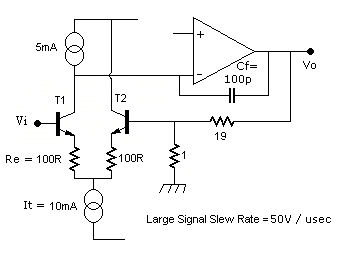
The amplifier has a gain of 20, so with a 1V input step we expect a 20V output step. If we apply a 1V input step with a slope of 1V/Ásec we then expect a 20V output step with a 20V/Ásec slope, well under the 50V/Ásec limit, so we could assume this is no problem.
To check this we can use a simulation to see how accurately the output signal follows the input. Maybe 50V/Ásec is not a sufficient margin, so we could try increasing the input stage tail current to 20mA, and the 5mA source increased to 10mA, which will increase the slew rate limit to 100V/Ásec. In the next diagram both the original and the increased current versions are simulated, and the output signals shown in red and green. The signal we were hoping for which is just the input step multiplied by the gain is shown in black.

This is not so good. Not only does the output fail to accurately duplicate the input step, but doubling the slew rate limit makes almost no difference, we need to look closely to see that there is actually a red trace almost entirely hidden behind the green. The small difference may be a result of the increased current increasing the gm value for the transistors, and the 100R resistors should have been increased slightly to compensate. Anyway, aiming for a high slew rate limit appears not to be at all helpful.
Just increasing the input stage current may not help, but there are other things we could do. What about changing the degeneration resistor values? This has no effect on the maximum slew rate, we still have exactly the same current available to charge Cf, but let's try it anyway. Here is what happens if we reduce the original 100R values (red) to 50R (green).
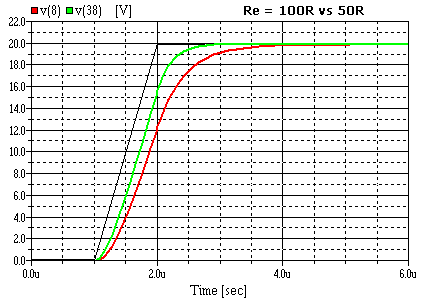
That's better, an obvious improvement. But wait, I have often read that to improve slew rate we need to increase the degeneration resistors not reduce them, so this looks wrong. The explanation is that by increasing the resistors we reduce the feedback loop gain, and to maintain the same unity gain frequency we can now reduce the compensation capacitor Cf without any serious effect on stability. That must surely make an improvement. If we reduce Cf to 50p with the 100R values for Re, and keep 100pF with Re = 50R, then we have the same unity gain frequencies, but the reduced capacitance will still have +/- 5mA available to charge it, and the slew rate limit once more increases to 100V/Ásec. Here is what happens:
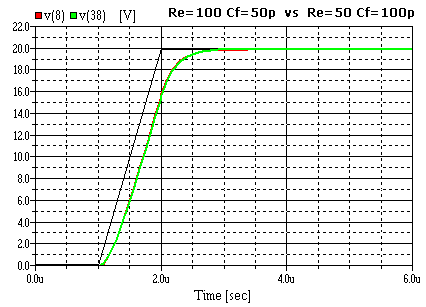
Again we have to look closely to see the red trace almost perfectly hidden behind the green. The high Re with low Cf has no benefit compared to lower Re and higher Cf. Again our effort to increase the slew rate limit seems pointless.
So, if we want to improve the transient accuracy of our amplifier what must we do? First of all we need to stop worrying about the slew rate limit, increasing that is not, in this example at least, of any help whether it is done by increasing the input stage current or by increased degeneration plus reduced compensation capacitor. Of course if the slew rate limit was low enough it would have some obvious effect, but if it is already adequate making it even higher makes little if any difference.
That second simulation, where there is a clear difference, is the one where the slew rate limits are identical, but the unity gain frequencies of the feedback loops are different. What we are changing there is the gain-bandwidth product (GBW), and increasing this is evidently a considerable advantage. We could have achieved the same improvement by keeping Re fixed but reducing the capacitor Cf (which would increase both the GBW and the slew rate limit). Clearly it is the gain-bandwidth we need to maximise in this example, not the slew rate limit. Stability considerations will however limit the extent to which the GBW can be increased.Increasing gain-bandwidth as far as possible was the conclusion in my articles about TID and PIM also, so it really does look like a good idea. It is usually at this point I mention that my MJR7-Mk5 has a gain-bandwidth somewhere approaching 1GHz, based on the open-loop gain x100,000 at 10kHz, and so it seems I should show the step response of that circuit here. However, that circuit has both an input filter and also a 10p feedback capacitor, chosen to create a second-order low-pass filter with -3dB gain at 60kHz. If we pass our step function through just that filter, without including any effects from the amplifier, we get the next result. I had to stretch the horizontal scale to show how long it takes the output to reach 20V.
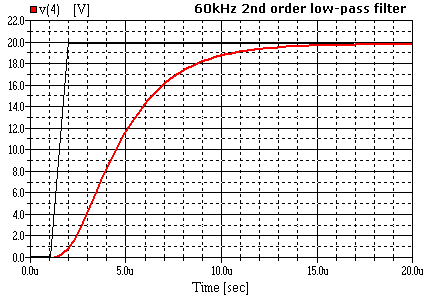
What makes this whole page an almost entirely pointless exercise is that the input step used for the simulations has a theoretically infinite bandwidth, and any amplifier bandwidth limitation will prevent it being accurately amplified. Of course audio signals are already band-limited before they reach our amplifier, and 1V steps with a 1Ásec rise-time are not possible input signals.
What we really need to look at is waveform distortion of these band-limited signals. An almost perfect linear phase shift vs frequency (better than +/- 1deg. linearity from 1kHz to 30kHz) for the MJR7 confirms that high frequency wave shapes will be accurately reproduced by the amplifier, and this includes all normal audio transients.There was a serious point, which was to demonstrate that amplifiers with very high specified slew rates are not necessarily either 'faster' or more accurately amplify transients than those with a lower specification.
In the next example the green step is from an amplifier with slew limit only 20V/Ásec, so having no safety margin at all, compared to the red step produced by an amplifier capable of 100V/Ásec, 5 times higher. The higher limit is evidently not helpful, the result is worse. The green step amplifier however has gain-bandwidth product 5 times higher, and clearly this is enough to more than make up for the lower slew limit.
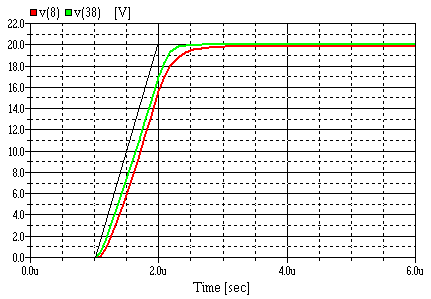
If the slew rate limit was made low enough it would of course eventually start to have a noticeable effect on even normal audio transients. 'Low enough' could be around 2.5V/Ásec for a 100W amplifier with a CD signal source, and not much more for the newer DVD-A and SACD sources, according to the findings of my Slew Rate and t.i.d. article. I think it is fairly certain any modern amplifier design will exceed that figure by a wide margin. The value of having a good margin is that input stage linearity will generally be better.
Footnote.
Although not relevant to the main subject here are two other interesting results from my simulations.
First, what happens if we use an even faster step as our test signal? Reducing the rise-time to 1 psec for the first simulation above, once more the higher input stage current has little effect:
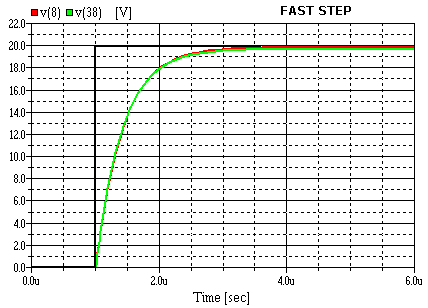
What is interesting is that the initial rise in output is far sharper and closer to the ideal response than for the slower step. It seems obvious that a slower step would be easier to follow, but that is not the case initially. The reason is that the fast step almost instantly applies the full 1V input, and the input stage is therefore driving close to its maximum output current into the compensation capacitor and so reaches a high slope very quickly. With the slower step there is initially a very low input voltage which rises to its maximum only after 1 Ásec. The lower input voltage up to that time can only drive the input stage up to a lower current, and the compensation capacitor charges slower giving a slower output slope.
The step response of the MJR7 is almost entirely determined by its low-pass filter effect, but what would happen if we exclude the filter effect and just look at the amplifier response to a step? The next result shows the response to the 1 Ásec step for the MJR7 (green) compared to a circuit with 100R degeneration resistors and increased input stage current to give a 100V/Ásec slew rate specification (red). I adjusted the MJR7 gain to 20 and eliminated the inversion to allow easier comparison with the standard circuit.
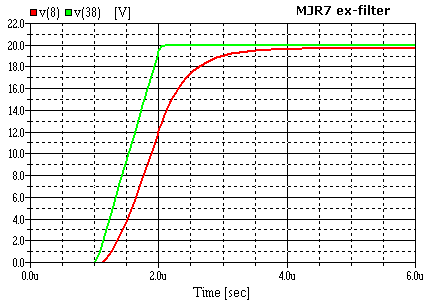
Here we see the high GBW in action, the step is almost perfect. The MJR7 would need some redesign to work without its 10p feedback capacitor, so this is cheating a little, but this does confirm that the MJR7 step response is almost entirely determined by its low-pass filter effect, it is not limited by slew rate considerations. Comparing slew rate specifications is clearly misleading, a circuit with higher slew rate limit can in practice be far poorer at amplifying transients than one with a lower specification but a higher gain-bandwidth. For normal band-limited audio signals none of this really matters, and as mentioned earlier the phase linearity in the audio band almost entirely determines the accuracy of normal audio transients unless the slew rate limit is exceptionally low.So, is there anything wrong with the usual differential input stage with 100R degeneration resistors? Not really, but using such a stage and then specifying a high slew rate limit is misleading, the trouble being that the specified slew rate is then only possible with something like a 1V differential input. With a 1V input step the differential input is only 1V if the amplifier output is zero so that there is zero voltage at the inverting input, and for an amplifier gain of 20 the output should be 20V, so we have a 20V output error. Being able to 'slew' at 100V/Ásec is not so impressive if it must be accompanied by a 20V output error.
The reality as seen in the above plot is that the output of such an amplifier can fail to achieve even 20V/usec, and at 1usec after the start of the step reaches 12V, still 8V short of the hoped for output. A 40% output error while failing to achieve even a fifth of the specified slew limit is not the sort of thing likely to be mentioned in amplifier specifications.The usual slew rate specification fails to mention the corresponding output error. If we specify power output or peak output voltage, we would perhaps mention that it is the value at which distortion reaches 1%, so is there any good reason not to use a similar error level for specifying slew rate?
As demonstrated earlier, the accuracy of the output has little or no relationship to the slew rate limit, it is more closely related to amplifier gain-bandwidth product, and is also strongly affected by any low-pass filtering included in the amplifier, so in practice the 1% error level is not very meaningful. We can however deduce something from the input stage design. If the input stage needs a differential input of 1V to drive its maximum current into the compensation capacitor to achieve for example 100V/usec at the output, then for an amplifier gain of 20 and an input step of 1V that slew rate can only be achieved when the step reaches 1V and with a zero output, otherwise the feedback will reduce the input stage differential voltage, and so we must have a 100% output error. If we only want a 1% output error then the output will be 19.8V when the input step reaches 1V, and the input stage differential input will then be just 10mV. It will then be able to drive only 1% of its maximum current into the compensation capacitor and so can reach only 1V/usec, so the specification of slew rate at 1% output error becomes just 1V/usec. This figure will not be improved either by increasing input stage current or by increased degeneration resistors combined with reduced compensation capacitor, but these steps may have other benefits such as reduced input stage distortion.